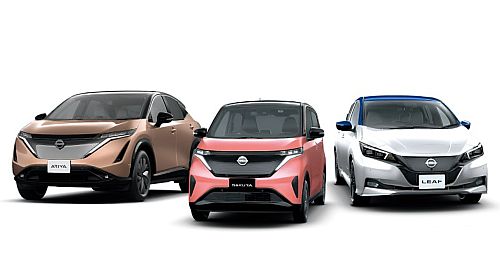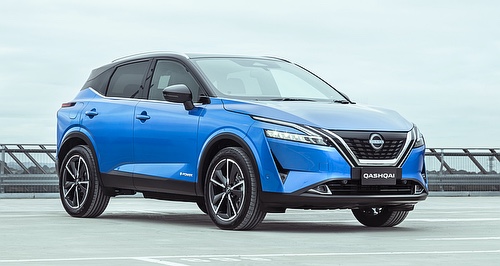News - NissanNissan supports NVES Option B... with some 'buts'Nissan Australia outlines what its submission for the NVES looked like, and there are some familiar factors11 Mar 2024 NISSAN Australia has outlined its take on the federal government’s New Vehicle Emissions Scheme (NVES), with the brand’s local boss outlining a number of key strategic considerations as part of the company’s submission, lodged earlier this week.
“I first wanted to start by saying that Nissan is fully committed to carbon neutrality, and to electrifying our powertrains and our portfolio,” said Mr Paterson at the launch of the new Nissan Qashqai e-Power hybrid SUV.
“We're clearly committed towards electric vehicles and carbon neutrality and because of our pioneering Leaf, we've worked with governments across the world for many years now to encourage the switch.
“At a local level, we have very much supported a clear national or federal strategy that provides direction to the industry and we're very happy to work with the Australian government to identify the right mix of policies that will deliver on the goals of NVES.
“Our long standing experience in other markets has shown that well-designed standards help consumers access a wider range of more accessible, affordable and efficient vehicles.
“So in concept, Nissan Australia is aligned to the government's Option B NVES proposal,” said Mr Paterson, with the brand aligning with a number of other big-selling marques in the market, such as Toyota and Hyundai.
According to the government’s impact analysis for NVES, Option B sets out to “provide enough flexibility to avoid extremely high costs” to consumers, as well as delivering “considerable abatement and fuel cost savings to Australians”.
Mr Paterson outlined some “key modifications” that he says the Japanese brand believes are needed to make the legislation “a success for consumers” and to decarbonise automotive in Australia.
“The first of those modifications is to smooth the implementation period, so the manufacturers such as ourselves had sufficient time to modify our vehicle range, or our model line-ups,” said Mr Paterson.
“I guess the challenge really is that we are here in early March, talking about legislation to launch in 10 months give or take from now.
“Product planning timelines are a little bit longer than that, generally speaking. The timeline that has been discussed is really challenging to meet local homologation or regulation requirements, to go through from a production standpoint, validation, etcetera, and get a product to market,” he said, claiming the current timeline is a “little bit ambitious to launch a product to market”.
Mr Paterson also outlined Nissan Australia’s calls for some adjustments to allow other vehicles to be sold here without having to undergo the stringent Australian Design Rule requirements that adds cost and complexity to the production line.
“We requested the government to amend Vehicle Type Approval requirements to allow direct acceptance of type-approved vehicles from global major markets in full volume supply, to speed up the introduction of new vehicles,” he said, referring to this as potentially allowing the brand to consider models sold in other developed markets like Japan and Europe, that currently can’t be sold here.
That could in turn open the door to smaller ‘kei’ class models, if Nissan were to be successful in its lobbying of that Vehicle Type Approval change.
“Essentially what that allows us to do is to access vehicles from other markets that still meet important regulatory requirements, and to bring them here faster. That's why that's requested,” he said.
Other inclusions in Nissan Australia’s submission to the government included the touchy subject of MC classifications for larger, off-road capable SUVs and utes.
“We believe that the MC category should be classified as an LCV or as LCVs. And this brings the standards in line with the design and usage requirements as well as their electrification pathway,” he said.
“Essentially these vehicles share very similar engineering standards, and as such should be classified and in the same category from our opinion. And the important removal of the mass breakpoints, as far as the scheme is set up. The target should be based on the actual vehicle mass as a result of the additional technology that is required to meet ADR requirements on those models.”
And to help drive the increased adoption of EV models, Mr Paterson said that, logically, consumer incentives – as have been employed in numerous other markets to drive the sales of zero-tailpipe-emissions models – should be considered at a federal level.
“It's very important to drive the demand side of the equation, as well as the availability side of the equation,” said Mr Paterson.
“We've seen in every major market that government incentives on the demand side help drive the uptake of electric vehicles and that's what we've articulated to the government as an important element of their scheme, or of the proposed legislation.”
Option B also doesn’t have any inclusion of a ‘credits’ scheme, which Mr Paterson said he’d like to see changed so that the imposed legislation would “introduce technology credits for zero emission vehicles”.
“Nissan is fully supportive of a clear federal mandate, and we applaud the government for moving in this direction and giving us the opportunity as a manufacturer to provide input into how they go about legislating this scheme,” he added.
Nissan Australia still hasn’t confirmed the timing of its second EV model, the Ariya SUV, which was believed to be on the cards for a 2024 debut.
To the end of February 2024, Nissan had shifted just 41 examples of the ageing Leaf EV, in a market that has seen a record 15,004 EVs registered in the first two months of the year.
Meanwhile, Nissan Australia had a very successful registrations tally for a number for February 2024, including the best result ever for the X-Trail SUV, plus best sales months for the current-gen Qashqai, and the highest figure for the Navara ute since December 2021.  Read more |
Click to shareNissan articlesResearch Nissan Motor industry news |

















Facebook Twitter Instagram